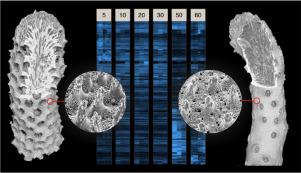Acta Biomaterialia ( IF 9.4 ) Pub Date : 2020-01-16 , DOI: 10.1016/j.actbio.2020.01.010 Assaf Malik 1 , Shai Einbinder 2 , Stephane Martinez 3 , Dan Tchernov 3 , Sivan Haviv 4 , Ricardo Almuly 5 , Paul Zaslansky 6 , Iryna Polishchuk 7 , Boaz Pokroy 7 , Jarosław Stolarski 8 , Tali Mass 5

|
Reef-building corals, the major producers of biogenic calcium carbonate, form skeletons in a plethora of morphological forms. Here we studied skeletal modifications of Stylophora pistillata (clade 4) colonies that adapt to increasing depths with decreasing ambient light. The coral show characteristic transitions from spherical morphologies (shallow depths, 5 m deep) to flat and branching geometries (mesophotic depths, 60 m deep). Such changes are typically ascribed to the algal photosymbiont physiological feedback with the coral that host them. We find specific fine-scale skeletal variability in accretion of structure at shallow- and mesophotic depth morphotypes that suggest underlying genomic regulation of biomineralization pathways of the coral host. To explain this, we conducted comparative morphology-based analyses, including optical and electron microscopy, tomography and X-ray diffraction analysis coupled with a comprehensive transcriptomic analysis of S. pistillata. The samples originated from Gulf of Eilat in the Red Sea collected along a depth gradient from shallow to mesophotic depths (5 to 60 m). Additional samples were experimentally transplanted from 5 m to 60 m and from 60 m to 5 m. Interestingly, both morphologically and functionally, transplanted corals partly adapt by exhibiting typical depth-specific properties. In mesophotic depths, we find that the organic matrix fraction is enriched in the coralla, well matching the overrepresentation of transcripts encoding biomineralization “tool-kit" structural extracellularproteins that was observed. These results provide insights into the molecular mechanisms of calcification and skeletal adaptation that repeatedly allowed this coral group to adapt to a range of environments presumably with a rich geological past.
Statement of Significance
Understanding the reef coral physiological plasticity under a rapidly changing climate is of crucial importance for the protection of coral reef ecosystems. Most of the reef corals operate near their upper limit of heat tolerance. A possible rescue for some coral species is migration to deeper, cooler mesophotic depths. However, gradually changing environmental parameters (especially light) along the depth gradient pose new adaptative stress on corals with largely unknown influences on the various biological molecular pathways. This work provides a first comprehensive analysis of changes in gene expression, including biomineralization “tool kit” genes, and reports the fine-scale microstructural and crystallographic skeletal details in S. pistillata collected in the Red Sea along a depth gradient spannign 5 to 60 m.
中文翻译:

Scleractinian珊瑚生物矿化的分子和骨骼指纹:从海面到中生深度。
造礁珊瑚是生物碳酸钙的主要生产者,以多种形态形成骨骼。在这里,我们研究了Stylophora pistillata的骨骼修饰(第4类)菌落适应于随着环境光线的减少而增加的深度。珊瑚显示出从球形形态(浅深度,5 m深)到平坦和分支几何形状(中观深度,60 m)的特征性转变。此类变化通常归因于寄养它们的藻类与光合细菌的生理反馈。我们在浅层和中生深度形态型上发现了特定的细尺度骨骼变异,表明珊瑚宿主生物矿化途径的潜在基因组调控。为了解释这一点,我们进行了基于形态学的比较分析,包括光学和电子显微镜,断层扫描和X射线衍射分析以及对S. pistillata的全面转录组分析。样本来自红海埃拉特湾,沿从浅到中生深度(5至60 m)的深度梯度采集。通过实验从5 m到60 m和60 m到5 m移植其他样本。有趣的是,在形态和功能上,移植的珊瑚通过表现出典型的深度特定特性而部分适应。在中生深度,我们发现珊瑚中的有机基质部分富集,与观察到的编码生物矿化“工具包”结构细胞外蛋白的转录本的过度表达非常吻合,这些结果为深入了解钙化和骨骼适应的分子机制提供了见解。反复地允许这个珊瑚群适应具有丰富地质历史的各种环境。
重要声明
了解珊瑚礁在快速变化的气候下的生理可塑性对于保护珊瑚礁生态系统至关重要。大多数珊瑚礁在其耐热上限附近工作。对于某些珊瑚而言,可能的拯救方法是迁移到更深,更凉的中生深度。但是,沿深度梯度逐渐变化的环境参数(尤其是光)会给珊瑚带来新的适应性压力,而对各种生物分子途径的影响很大程度上未知。这项工作提供了包括生物矿化“工具箱”基因在内的基因表达变化的首次综合分析,并报告了S. pistillata中的精细尺度的微观结构和晶体学骨骼细节 在红海沿5至60 m的深度梯度收集。











































 京公网安备 11010802027423号
京公网安备 11010802027423号